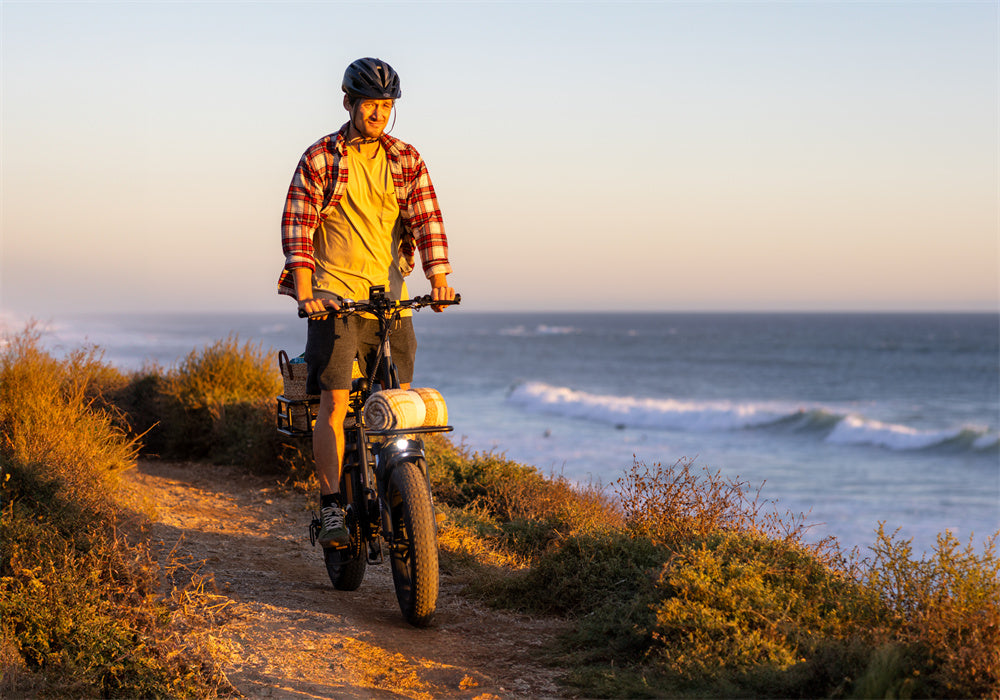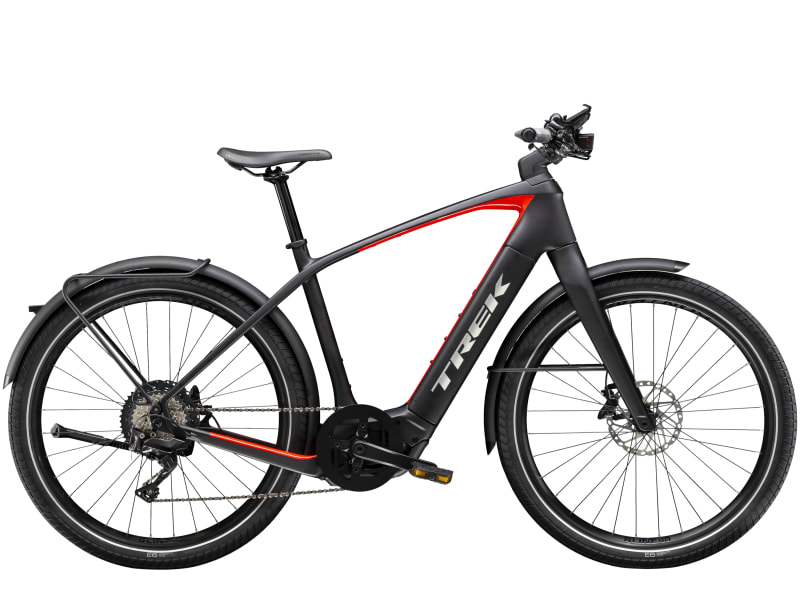Ebikes have revolutionized the way we commute, exercise, and explore the world. With a variety of models to choose from. This comprehensive guide delves into the various ebike categories, helping you find the perfect match for your needs.
Who Invented the First E-bike?
From the early concepts to the sophisticated models we ride today, the journey of the electric bike reflects the relentless pursuit of efficiency and sustainability in transportation.
Early Beginnings
The concept of the electric bicyle can be traced back to the late 19th century. In 1895, Ogden Bolton Jr. filed one of the first patents for an electric bicycle. His design featured a battery-powered bicycle with a motor mounted on the rear wheel hub. Although this initial design was rudimentary, it laid the foundation for future innovations in electric bicycles.
Albert Augustus Hanson's Contribution
In 1896, another significant patent was filed by Albert Augustus Hanson. Hanson's design incorporated a motor that drove a belt, which then powered the rear wheel. This concept introduced a more practical approach to integrating electric propulsion with a traditional bicycle frame, marking a crucial step forward in the evolution of ebikes.
Modern Advancements
Despite these early inventions, elctric bikes didn't gain widespread popularity until the late 20th century. It was during the 1990s that advances in battery technology and electric motors made electric bicycle more practical and accessible.
One notable inventor during this period was Yamaha, a company known for its contributions to the development of modern ebikes. In 1993, Yamaha introduced the first commercially successful ebike, the PAS (Power Assist System).
This model featured a pedal-assist system that provided electric power only when the rider pedaled, setting a standard for many electric bikes that followed.
The Rise of Ebikes in the 21st Century
The early 2000s saw an explosion in the popularity of electic-bicycle, driven by several key factors:
Electric bikes emerged as a viable solution for urban commuting, offering an eco-friendly and efficient alternative to cars and public transport. Growing awareness of environmental issues and the need for sustainable transportation options boosted the appeal of ebikes.
The development of lithium-ion batteries significantly improved the range and efficiency of electirc bikes.
Several brands and innovators have played a pivotal role in shaping the modern electric bicycle industry. Known for its high-performance electric motors and battery systems, Bosch has become a leading name in ebike technology.
While primarily focused on electric cars, Tesla's advancements in battery technology have indirectly influenced the ebike market. This American brand has been at the forefront of integrating advanced electric components into high-performance bicycles.
City Ebike
City ebikes, also known as urban ebikes, are designed for daily commuting and short trips around town. These ebikes feature a lightweight frame, efficient motor, and practical accessories such as fenders, lights, and racks. They offer a comfortable riding position, making them ideal for navigating city streets and traffic.
City ebikes typically have 700c wheels with narrow tires for smooth rolling on paved surfaces. The frame designs often include step-through models for easy mounting and dismounting, which is particularly useful in stop-and-go traffic. City ebikes are often equipped with features like integrated lighting systems for visibility, built-in racks for carrying groceries or briefcases, and chain guards to protect clothing from getting dirty. They are generally lighter and more compact than other ebike types, making them easy to store in apartments or offices.
Product Recommendation
TESWAY COMET-FPrice: $1399.00
Frame Material: Aluminum
Tire Size: 700c
Weight: 44.1 pounds
Maximum Total Weight: 280 pounds
Motor: 500W
Battery: 672Wh Integrated
Drivetrain: Shimano 7 speed
Brakes: Hydraulic Disc Brakes
Fat Tire Ebike
Fat tire ebikes are designed to handle various terrains, including snow, sand, and mud. They feature oversized tires, typically 4 inches or wider, that provide excellent traction and stability. These ebikes are equipped with powerful motors and durable frames, allowing them to tackle rough and uneven surfaces with ease. The wheel hubs are generally larger, around 26 inches, providing additional stability and support.
Fat tire ebikes often come with a robust suspension system to absorb shocks from rough terrains. The tread on the tires is usually deeper and wider, ensuring better grip and control in off-road conditions. These bikes are built for adventure, with sturdy frames that can withstand the rigors of off-road biking. They are perfect for outdoor enthusiasts who enjoy exploring challenging environments and need a reliable bike that can handle diverse terrains.
Product Recommendation
TESWAY S7
Price: $899.00
Frame Material: Aluminum
Tire Size: 26 inches x 4 inches
Weight: 43.4 pounds
Maximum Total Weight: 330 pounds
Motor: 750W Geared Hub Motor
Battery: 48V, 20 Ah (960 Wh)
Drivetrain: 7-speed Shimano Altus
Brakes: Hydraulic Disc Brakes
Folding Ebike
Folding ebikes are designed for convenience and portability. They feature a compact frame that can be easily folded and stored, making them ideal for commuters and travelers. These ebikes are lightweight and easy to carry, allowing you to take them on public transportation or store them in small spaces.
Folding ebikes usually fold down to a size of approximately 85 cm x 65 cm x 45 cm, making them compact enough to fit in car trunks, closets, or under desks. The folding mechanism is quick and simple, allowing users to collapse the bike within seconds. Despite their compact size, folding ebikes do not compromise on performance. They are equipped with reliable motors and batteries, offering a decent range for city commuting. The frames are often made of lightweight yet durable materials like aluminum or steel.
Product Recommendation
TESWAY X5
Price: $1059.00
Frame Material: Aluminum
Tire Size: 20 inches
Weight: 105 pounds
Maximum Total Weight: 350 pounds
Motor: 750W Gear Hub Motor
Battery: 1200Wh
Drivetrain: 5 Level
Brakes: Disc Brakes
Touring Ebike for Long Distance Travel
Touring bikes, originally for long-distance travel, are now ideal for everyday cycling. Adding electric motors extends their range, making them even more versatile. They come in various frame styles, including step-through, diamond frame, and low-step for easy access.
Equipped for daily use, touring e-bikes feature lights, fenders, a rear luggage rack, and a kickstand. For longer trips, a rear-mounted kickstand stabilizes the bike when fully loaded. Aluminum frames are common, with options for 700c or 27.5-inch tires,even 20-inch fat tire. These bikes often include mountain bike components like durable derailleurs, gears, and disc brakes. Suspension forks are standard, with some models offering rear suspension and seat suspension for added comfort.
Product Recommendation
Trek Allant+ 9.9S
Price: $5,999
Frame Material: Carbon Fiber
Tire Size: 27.5 inches
Weight: 51 pounds
Maximum Total Weight: 300 pounds
Motor: Bosch Performance Speed, 350W
Battery: Bosch PowerTube 625 Wh
Drivetrain: Shimano XT/SLX 12-speed
Brakes: Hydraulic Disc Brakes
E-Road Bikes
E-road bikes are designed for road cycling enthusiasts who want to enjoy the benefits of an electric motor while maintaining the lightweight and aerodynamic features of a traditional road bike. These ebikes are equipped with powerful motors and high-capacity batteries, allowing riders to tackle long distances and steep climbs with ease.
E-road bikes typically have 700c wheels with narrow, smooth tires for maximum efficiency on paved roads. The frames are lightweight, often made from carbon fiber or high-quality aluminum, to enhance speed and maneuverability. E-road bikes also feature aerodynamic designs, drop handlebars, and performance-oriented gearing systems. The motors and batteries are integrated seamlessly into the frame to maintain a sleek and streamlined appearance. These bikes are perfect for competitive cyclists or anyone looking to extend their riding range without sacrificing speed and efficiency.
Product Recommendation
Giant Road E+ Pro
Price: $4,500
Frame Material: Aluminum
Tire Size: 700c
Weight: 40 pounds
Maximum Total Weight: 275 pounds
Motor: Giant SyncDrive Pro, 250W
Battery: 375Wh
Drivetrain: Shimano Ultegra, 11-speed
Brakes: Hydraulic Disc Brakes

E-MTBs (Electric Mountain Bikes)
E-MTBs are designed for off-road riding and mountain biking. They feature powerful motors and durable frames, allowing them to tackle steep inclines and rough terrains. These ebikes are equipped with advanced suspension systems and high-performance components, providing a smooth and controlled ride on challenging trails.
E-MTBs typically have 27.5-inch or 29-inch wheels with knobby tires for better traction on dirt and gravel paths. The frames are often made of robust materials like aluminum or carbon fiber to withstand the rigors of mountain biking. E-MTBs also come with wide-range gearing systems to handle varying terrain and powerful hydraulic disc brakes for reliable stopping power. The suspension systems, both front and rear, are designed to absorb shocks and bumps, making the ride comfortable and stable.
Product Recommendation
Specialized Turbo Levo SL
Price: $6,500
Frame Material: Aluminum
Tire Size: 29 inches
Weight: 38 pounds
Maximum Total Weight: 300 pounds
Motor: Specialized SL 1.1, 240W
Battery: 320Wh Integrated
Drivetrain: SRAM NX Eagle, 12-speed
Brakes: SRAM Guide RE Hydraulic Disc Brakes
Conclusion
Understanding the different types of ebikes can help you make an informed decision when choosing the right model for your needs. Whether you’re looking for a reliable commuter bike, an off-road adventure machine, or a high-performance road bike, there’s an ebike for everyone. Best electric bikes at TESWAY!
FAQs
How much does an electric bike cost?
Electric bike prices vary widely depending on the type, features, and quality. Entry-level models can start around $1,000, while high-end models with advanced features can exceed $5,000.
Can I ride an electric bike in the rain?
Most electric bikes are designed to be water-resistant and can handle light rain and wet conditions. However, it's advisable to avoid submerging the bike or exposing it to heavy downpours for extended periods. Always check the manufacturer's guidelines for specific recommendations.
Do I need a license to ride an electric bike?
In many regions, electric bikes that meet certain criteria (e.g., maximum speed, motor power) do not require a license, registration, or insurance. However, regulations can vary, so it's essential to check local laws before riding.













Share:
Ebike Motor: Everything Explained
What You Need to Know Before Buying an Electric Bike